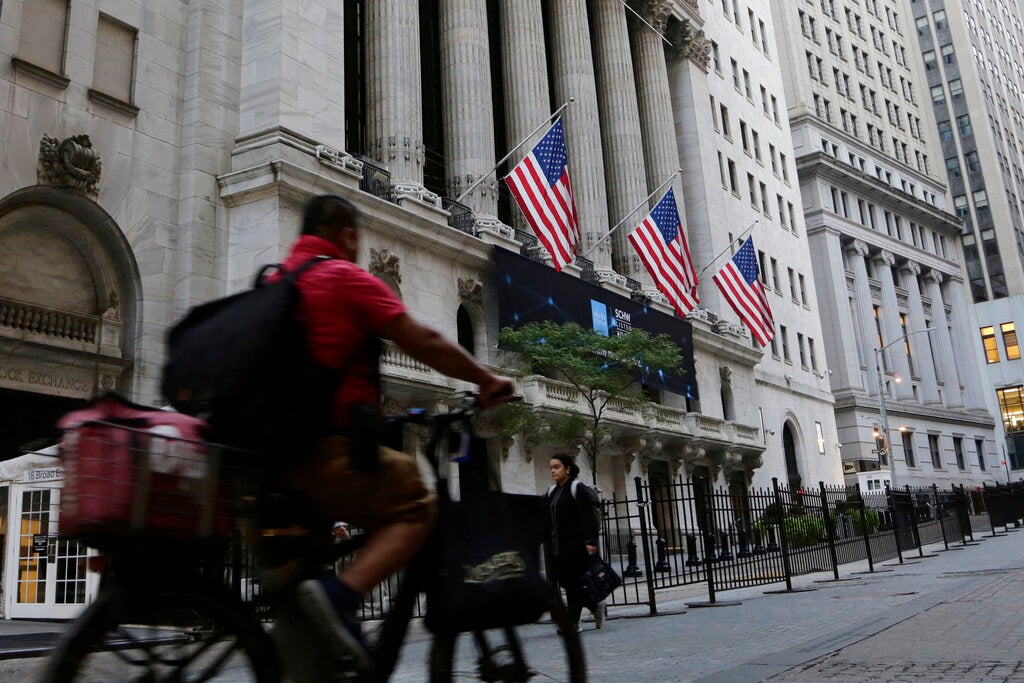Stocks rally, bonds soar in relief after UK calms markets
NEW YORK (AP) — Stocks rallied on Wall Street to their first gain in more than a week, as some calm returned to markets around the world Wednesday after the Bank of England moved forcefully to get a budding financial crisis there under control.
The S&P 500 jumped 2% for its best day in seven weeks to snap its longest losing streak since the coronavirus crash in February 2020. Besides the relief on Wall Street, bond markets around the world also relaxed and European stocks erased morning losses after the U.K. central bank said it would buy however many U.K. government bonds are needed to restore order to its financial markets.
The drop in bond yields eased some of the pressure that’s been choking Wall Street this year, and the Dow Jones Industrial Average rallied 1.9%. The Nasdaq composite climbed 2.1%, and the smaller stocks that make up the Russell 2000 index soared even more, 3.2%.
The moves helped markets recover recent losses triggered by turmoil in U.K. financial markets. After the government there announced a sweeping set of tax cuts, investors worried the attempts to goose the U.K. economy could push already high inflation even higher. That caused the value of the British pound to plunge and bond yields globally to jump.
Despite Wednesday’s rally, the U.S. stock market is still down more than 20% from its record set early this year and remains near its lowest point since late 2020. Analysts say more turbulence is likely ahead as worries about a possible recession, higher interest rates and even higher inflation continue to hang over Wall Street.
Underscoring those concerns, the yield on the 10-year U.S. Treasury briefly topped 4% Wednesday morning to touch its highest level in more than a decade. It’s been on a swift surge along with other Treasury yields as the Federal Reserve jacks up short-term interest rates at the fastest pace in decades.
By raising rates, the Fed is hoping to slow the economy enough to force down the high inflation that’s hammering the economy. But it risks creating a recession if it takes rates too high too quickly. Already, the housing industry has been hurt in particular as mortgage rates have jumped to their highest levels since 2008.
A recession appears to be inevitable, according to Liz Ann Sonders, chief investment strategist at Charles Schwab. She points to several discouraging signals, including six straight months of contraction for an index of leading economic indicators. That hasn’t happened since the beginning of the global financial crisis two recessions ago.
Investment giant Vanguard puts the chance of a U.S. recession at 25% this year and at 65% next year on expectations for the Fed to keep hiking rates and to likely hold them at high levels through 2023.
Besides the worries about higher rates from the Fed and other central banks, a litany of other pressures on the market are also lurking.
Among them: Investors are worried that the stress caused by a huge run for the U.S. dollar’s value against other currencies could make something crack somewhere in global markets. In Europe, tensions are rising even further amid Russia’s invasion of Ukraine, with suspicions about sabotage to important natural gas pipelines the latest flashpoint. And profits for U.S. companies are under threat because of the slowing economy, high inflation and rising dollar.
For Wednesday at least, though, the market seemed to be focused more on relief than such worries.
“Investors got a sense that maybe central banks blinked, or at least the central bank of England blinked. That has led to lower rates” for longer-term U.S. bonds, said Jack Ablin, chief investment officer at Cresset. “And that has helped push stocks higher.”
Following the Bank of England’s bond-buying announcement, the yield on the 10-year U.S. Treasury sank sharply to 3.73% from 3.95% late Tuesday. In the U.K., the 10-year yield tumbled by roughly half a percentage point to a shade above 4%
On Wall Street, a widespread rally saw nearly 35 stocks rise in the S&P 500 index for every one that fell. Health care stocks helped lead the way following an encouraging update on a potential treatment for Alzheimer’s disease.
Japan’s Eisai said its potential treatment appeared to slow the fatal disease in a late-stage study. Shares of Biogen, which will co-promote the drug, soared 39.9%.
Stocks of energy producers were also strong after crude oil prices recovered some of their steep recent losses caused by recession worries.
The S&P 500 rose 71.75 points to close at 3,719.04. The Dow gained 548.75 to 29,683.74, and the Nasdaq climbed 222.13 to 11,051.64.
Wall Street’s rise came despite a 1.3% drop for Apple, which is the most influential stock in the S&P 500 because it’s the largest. It was hurt by a report from Bloomberg that said soft demand for the latest iPhone model is pushing Apple to back off plans to increase production.
Earlier in the morning, before the Bank of England’s announcement, stocks across Asia fell. Hong Kong’s Hang Seng lost 3.4%, South Korea’s Kospi fell 2.5% and Japan’s Nikkei 225 dropped 1.5%. China’s yuan also fell to a 14-year low against the dollar despite central bank efforts to stem the slide. .



